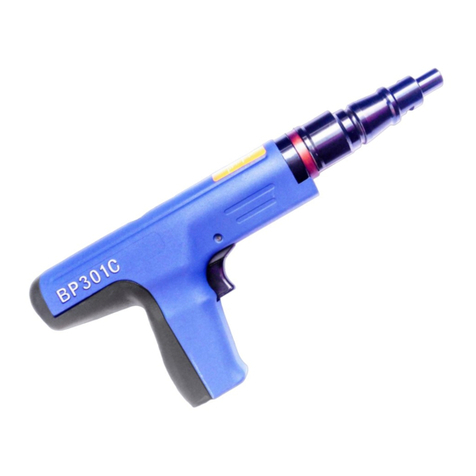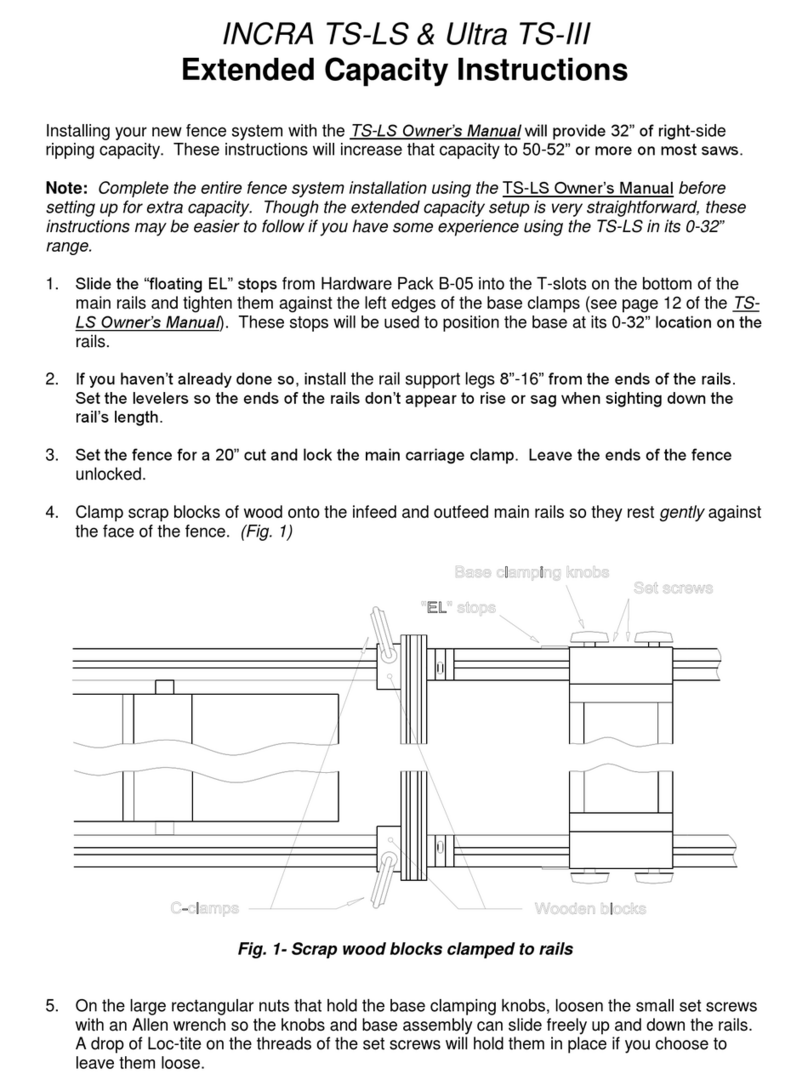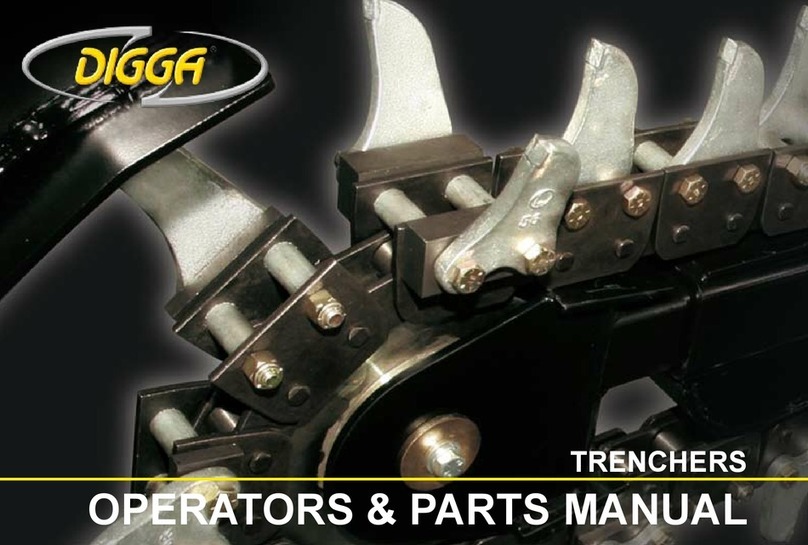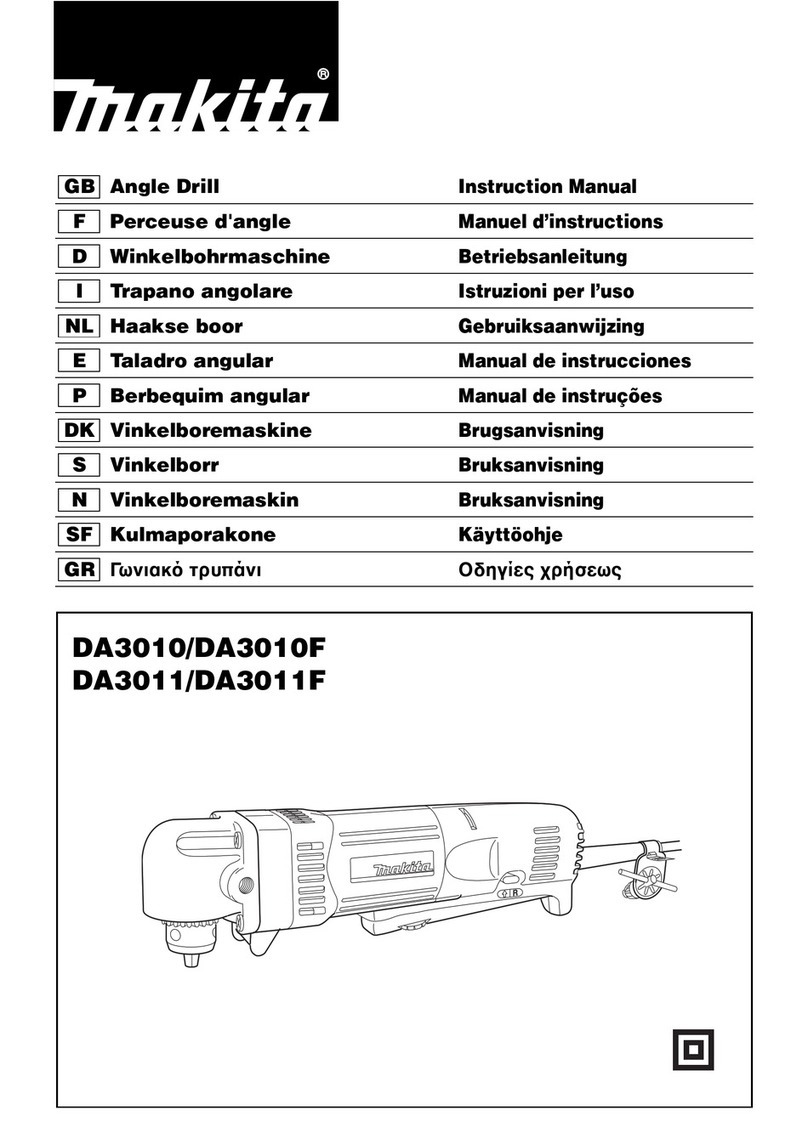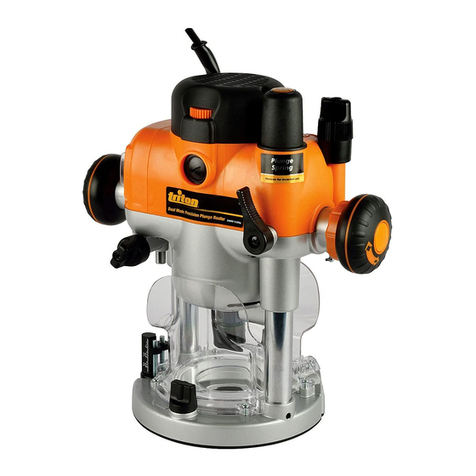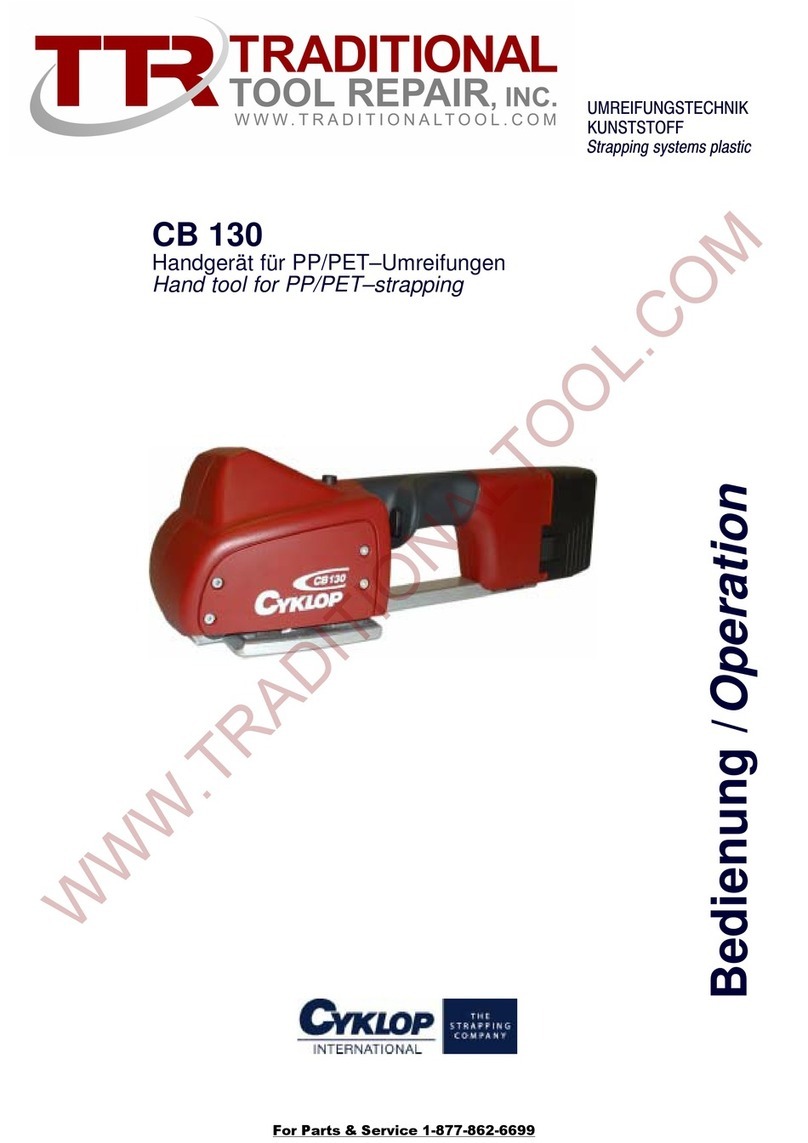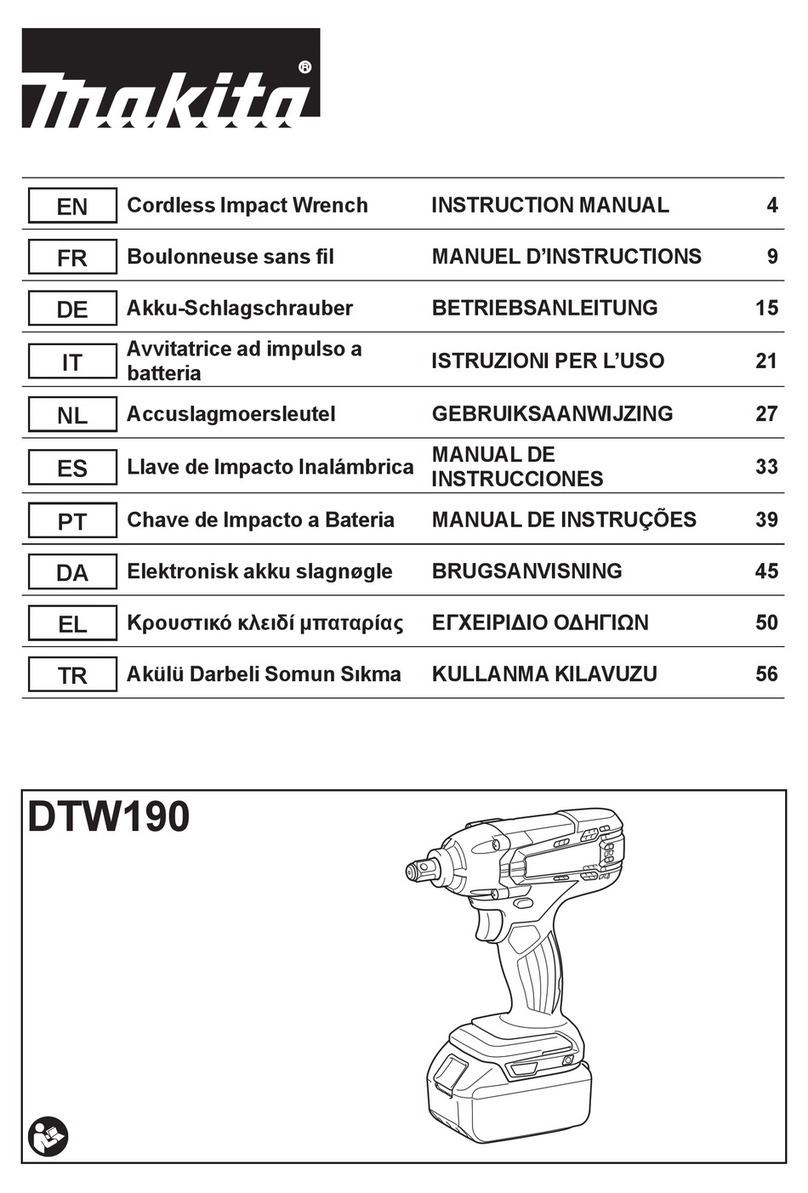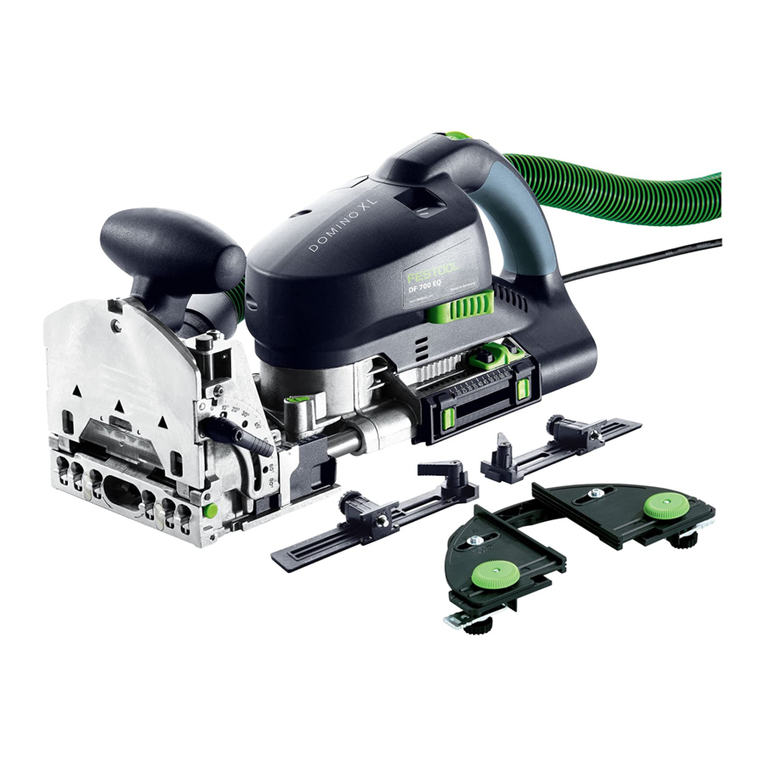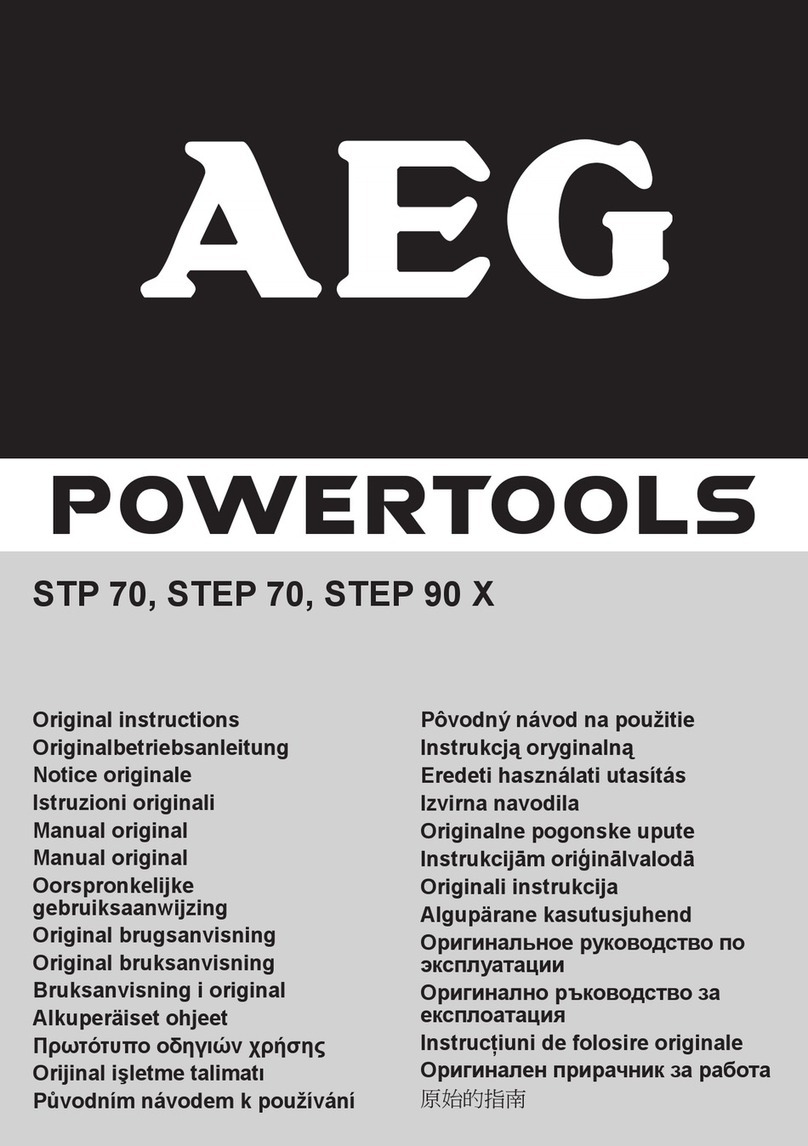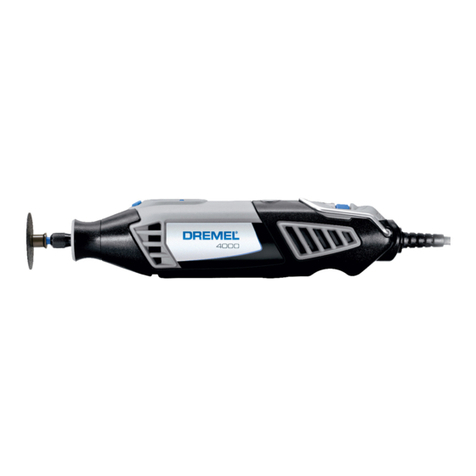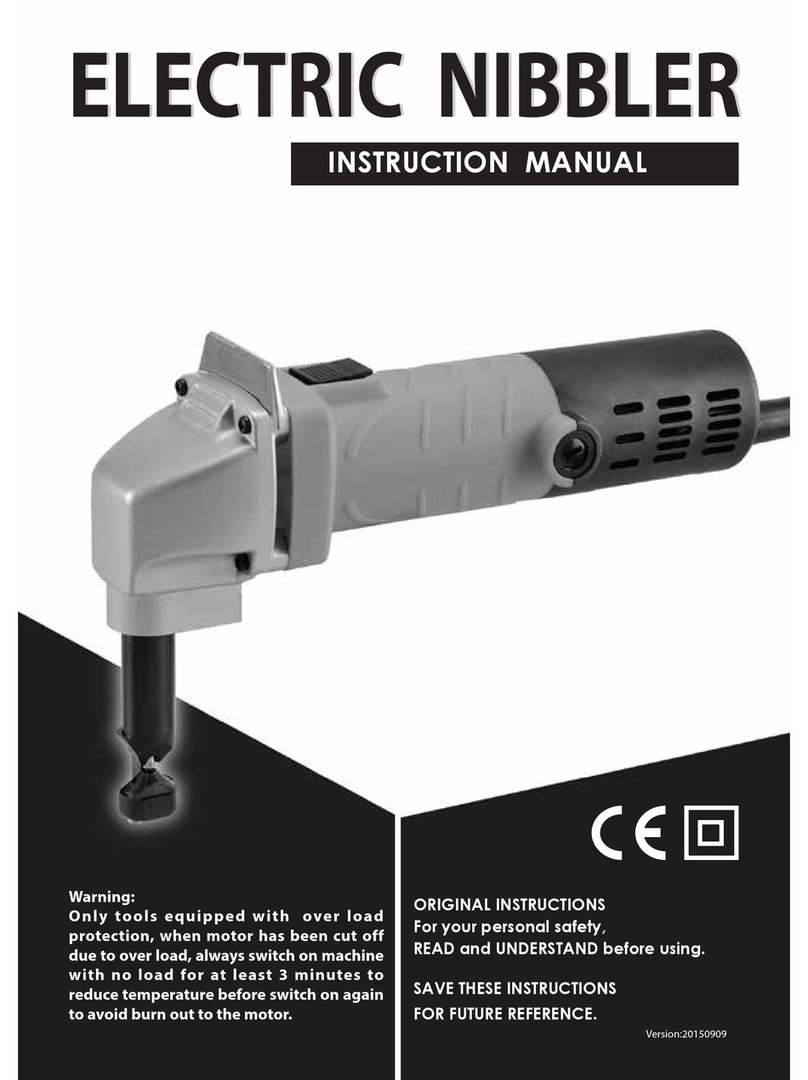BluePoint Fasteners BP-361 User manual

Instruction
Manual
BP-361
BP-361M
BP-361N
WARNING!
DO NOT OPERATE THE TOOL UNTIL YOU HAVE READ THIS TOOL TRAINING
MANUAL AND EDUCATION HAS BEEN RECEIVED ACCORDING TO
ANSI STANDARD A 10.3-1995.
READING AND FOLLOWING THIS INSTRUCTION MANUAL CAN HELP
AVOID SERIOUS INJURY OR DEATH.
01

PRIOR TO OPERATING THE BP361 TOOL, PLEASE STUDY THIS MANUAL CAREFULLY
AND DEVELOP A THOROUGH UNDERSTANDING OF THE CONTENTS. PROPER
TRAINING ACCORDING TO THE CURRENT ANSI STANDAR D A 10.3, SAFETY
REQUIREMENTS FOR POWDER ACTUATED FASTENING SYSTEMS MUST BE
COMPLETED AND A BLUEPOINT FASTENERS QUALIFIED OPERATOR CARD MUST BE
OBTAINED PRIOR TO OPERATION OF THE TOOL. STATE, LOCAL, OR OTHER
REGULATIONS SHOULD ALSO BE FOLLOWED. LAWS, REGUATIONS, AND STANDARDS
REGARDING THE USE OF POWDER ACTUATED TOOLS MAY PERIODICALLY BE REVISED
WITHOUT NOTICE. ANY SUCH REVISIONS MAY CHANGE THE SAFETY AND OPERATING
PROCEDURES DESCRIBED IN THIS MANUAL. BLUEPOINT FASTENERS IS NOT
RESPONSIBLE FOR ANY SUCH REVISIONS WHICH OCCUR AFTER PUBLICATION OF THIS
MANUAL. IT IS THE RESPONSIBILITY OF THE USER TO MAINTAIN ALL KNOWLEDGE OF
THE LAWS, REGULATIONS, AND STANDARDS THAT APPLY TO POWDER ACTUATED
TOOLS.
WARNING!
BP361 TOOL IS TO BE USED ONLY BY LICENSED OPERATORS. YOU MUST HAVE A
LICENSE BEFORE OPERATING IT. YOU MAY COMPLETE THE ENCLOSED EXAM
SUCCESSFULLY AND RETURN IT TO GET A TOOL OPERATOR’S CARD THAT WILL
BE ISSUED TO YOU, AND ALSO ACTIVATE YOUR WARRANTY. OPERATOR’S
LICENSE CAN ALSO BE OBTAINED DIRECTLY AT: www.bpfasteners.com
WARRANTY
Bluepoint warranty assures that the supplied tool is free of defects in workmanship
or material. Validity of this warranty is applied as long as the tool is handled and
operated correctly, serviced and cleaned properly in accordance with the Bluepoint
Instruction Manual and only if original Bluepoint components, consumables and
spare parts or other equivalent quality products are used. Parts requiring
replacement or repairs as a result of normal wear and tear are not covered under this
warranty.
All warranties or products described herein, expressed or implied, including the
warranties of merchantability or fitness for a particular purpose, are specifically
excluded, with the following exceptions: Bluepoint Fasteners will repair or replace, at
its option, any tool, part or element holding that, within 90 days after the sale, only if
Bluepoint is found to be responsible for a defective part in material or workmanship,
excluding normal wear.
All additional claims are excluded, specifically, Bluepoint is not obligated for direct,
indirect, incidental or consequential damages, losses or expenses in connection with,
or by reason of, the use of, or inability to use the tool for any purpose.
THIS IS THE ONLY WARRANTY AND REMEDY BLUEPOINT HAS AVAILABLE AND
IS IN NO EVENT LIABLE FOR ANY DIRECT, INDIRECT, INCIDENTAL OR
CONSEQUENTIAL DAMAGES, OR ANY OTHER DAMAGES.
Always keep this instruction manual together with the tool and ensure that
they are handed over together to any other operator.
General information
Explanation of Terminology
WARNING
The word WARNING is used to
emphasize a potentially
dangerous situation which could
lead to severe personal injury or
death.
CAUTION
The word CAUTION is used to
emphasize a potentially dangerous
situation which could lead to minor
personal injury or damage to the
equipment or other property.
Graphic Symbols
GENERAL INFORMATION
DANGER! TO AVOID SERIOUS INJURY OR DEATH:
NEVER PLACE YOUR HAND AT THE END OF THE FASTENER GUIDE OF THE 361 TOOL.
OPERATORS AND BYSTANDERS AROUND THE TOOL BEING USED MUST USE EYE AND
EAR PROTECTION. ALWAYS ASSUME THAT THE TOOL IS LOADED WITH A LOAD.
NEVER PLACE YOUR FINGERS ON THE TRIGGER OF THE LOADED OR UNLOADED TOOL
UNTIL THE TOOL FASTENER GUIDE IS AGAINST THE WORK BASE AND YOU ARE READY
TO DO A FASTENING. IF THE TOOL ACCIDENTALLY SHOOTS HIS/HER HAND OR ANY
PART OF THE BODY, THE PISTON CAN ENTER THE BODY AND CAUSE SERIOUS INJURY
OR DEATH. IT IS VERY IMPORTANT THAT THE OPERATOR OF THIS 361 TOOL READS
AND UNDER STANDS THE ENTIRE MANUAL AND COMPLETES THE OPERATORS EXAM
WITH A 100% GRADE. THE WARRANTY DOES NOT APPLY UNTIL BLUEPOINT
FASTENERS RECEIVES A COPY OF OPERATORS EXAM AND A COPY OF YOUR RECEIPT
WHEN THE TOOL WAS PURCHASED.
General Warning
Read Instructions Before
Use
Use Safety Helmet
Use Eye Protection
Use Ear Protection
WARNING! Hot Surface
0302

1. General Safety Instructions
The following points must be
strictly observed at all times, in
addition to the specific safety
precautions listed in the individual
sections.
2. Use as recommended
The tool is designed for use only by
professionals in the construction
industry for fastening applications
where threaded studs, nails or
composite fasteners are driven into
steel, concrete or sand-lime block
masonry.
3. Inappropriate use
•Modification or manipulation of the
tool is not permitted.
•Unless the tool is approved for such
use, it should not be used in a
flammable or an explosive
environment.
•Use only BLUEPOINT fasteners,
cartridges, accessories or spare
parts of equivalent quality to avoid
risk of injury.
•Strictly follow the instructions for
operation, care and maintenance
given in the Instruction Manual.
•The tool should never be pointed at
self or any bystander.
•The muzzle of the tool should never
be pressed against a hand or any
body part.
•The nails are NOT to be driven into
materials such as marble, natural
rock, glass, copper, brass, bonze,
plastic, insulation materials, hollow
brick, glazed tile, thin sheet metal
(<4 mm), grey cast iron, spheroidal
cast iron or gas concrete.
•The tool and its accessories may be
hazardous if used improperly by an
unauthorized person.
4. Workplace safety
•Avoid unergonomic body postures.
•Hazardous objects should be
removed from the work area.
•The tool is only for hand-held use.
•Other bystanders, particularly
children, should not be allowed in
the work area.
•Make sure nobody is behind or
below the point where the fastener
is to be driven.
•The tool grip should always be kept
free of oil or grease.
5. Basic safety precautions
•Operate the tool only in good
condition and only as directed.
•Use the spall guard / stabilizer
when required.
•If the cartridge fails to ignite or
misfires, please do the following:
•Hold the tool pressed against
the working surface for 30
seconds.
•If the cartridge still fails to fire,
withdraw the tool from the
working surface making sure it
is not pointed towards
anybody or yourself.
•Manually advance by one
cartridge and use the
remaining cartridges on the
strip.
•If 2-3 cartridges misfire in
succession (without making any
audible firing noise and if the
fastener is driven with significantly
less force), do the following:
•Immediately STOP using the
tool.
•Dismantle the tool.
SAFETY PRECAUTION
•Ensure that the correct
combination of piston,
fastener guide, and fasteners
are used.
•Check the piston, buffer and
fastener guide / magazine and
replace the worn out parts if
necessary.
•Clean all the parts of the tool.
•If the problem persists, DO
NOT use the tool . Have the
tool checked / repaired by a
Bluepoint professional.
SAFETY PRECAUTION
•Never try to pry a cartridge from the
magazine strip or the tool.
•Do not straighten your arms while
firing the tool. Keep them flexed.
•Never leave the loaded tool
unattended.
•Ensure that the tool is not loaded
before servicing, cleaning or
replacing parts and before storing it.
•Always store cartridges and unused
tools unloaded, in a dry location,
and in a high or locked place, out of
children’s reach.
6. Temperature
•Do not dismantle the tool when it is
hot.
•Never exceed the recommended
maximum fastener driving rate. (700
fastenings / hour).
•Stop if the plastic cartridge strip
melts. Allow the tool to cool down.
7. Requirements to be met by users
(Pre-requisites for users)
•Only authorized, trained
professionals should operate,
service, and repair the tool. The
professional must be informed of
any special hazards that may be
encountered.
•Operate the tool only if your full
attention is on the job.
•Do not use the tool if you feel
unwell.
8. Personal Protective Equipment
(PPE)
•The operator and all other
bystanders must always wear eye
and ear protection and a hard hat.
Prior to use
9. Read the Instruction Manual
carefully.
10. Inspection of tool
•Ensure that the tool is not loaded.
•Routinely check the tool for damage
and ensure that all controls operate
properly.
•Check the buffer and piston for wear
(see table on last page of these
instructions).
11. Selection of the correct fastener
guide / piston / fastener
combination
•Using the wrong combination may
result in damage to the tool and / or
affect fastening quality.
0504

SAFETY PRECAUTION
Tool operators and bystanders
must wear ear and eye protection.
Read the manual thoroughly before
operating the tool.
Never keep a hand over fastener
loading end of the tool. A serious
hand injury may occur from
penetration by the piston or a
discharged fastener.
SAFE HANDLING OF TOOLS
1. Always make sure that the tool is
working properly before use.
Follow the daily checklist. See the
example located in the instructions
under maintenance section.
2. Always use certified BLUEPOINT
loads from a box indicating the
type of load, power and number.
Never attempt to use unknown
power loads.
3. Never carry loads in pockets with
other loose pins or other objects.
Doing so may cause the load to fire.
4. Never load a tool unless you
intend to use it immediately.
Unattended loaded tool in the
workplace may result in its
accidental discharge by others.
5. Never place your hands or any
other body part on the tool
muzzle. It can cause serious injury
from the fastener or piston if the
tool is fired accidently.
6. Always unload the tool and store it
along with the loads safely locked in
a tool box. Keep the keys away from
children and unauthorized persons.
7. Never point the tool at yourself or
others.
8. Never play with the tool.
9. Ensure adequate ventilation at all
times.
0706

Suitable Base Materials:
Only the following materials are suitable
for Powder-actuated fastening:
•Structural Steel
•Masonry Joints
•Poured Concrete
DO NOT try to fasten into any other
type of materials. It can cause serious
injury or blindness.
Unsuitable Base materials that should
not be fastened to:
Never try to fasten into very hard or
brittle materials such as tile, glass, cast
iron or rocks of any kind. These
materials can break or shatter causing
spall and may cause serious injury to the
tool operator and the bystanders.
PREPARATION
BP361 is a semi-automatic feeding low velocity powder-actuated fastening
tool. Continuous feeding of powder loads and pins for a wide range of
applications, make the BP361 tool a versatile, portable, safe and reliable tool.
INTRODUCTION
Never fasten directly to a base
material easily penetrated like
wood or gypsum board. These
types of materials may cause the
fasteners to penetrate through to the
other side making it dangerous for
other people in the work area.
Never fasten into a base material
that fails the center punch test.
Failure to check the suitability of the
base material can cause serious
injury to the eyes or other body parts.
Never try to fasten into very hard
or brittle materials.
Never fasten directly to a base
material easily penetrated like
wood or gypsum board.
Center Punch Test
MUST WEAR EYE
PROTECTION WHILE
PERFORMING THIS TEST.
1. Always check the hardness of the
base where you want to fasten.
2. Using a fastener as a center punch,
strike the fastener with a hammer
against the work surface and check
the results.
1. Operators and bystanders must always
wear approved ear and eye protection.
Failure to do so can cause blindness or
serious eye injury from debris, and
hearing loss from exposure to constant
or repeated noise from the fastening
tool.
2. Keep the work area clear of
unnecessary materials and bystanders
that may interfere with the safe
operation of the tool. Operating tool in
a congested or disorganized area may
affect the ability to operate safely.
Center Punch Test Result
1. The material is too hard for a powder
actuated fastening, if the fastener point
is flattened.
2. The material is too soft, if the fastener
easily penetrates it.
3. The material is too fragile, if the
material cracks or shatters.
4. The material is suitable for powder
actuated fastening, if the fastener
causes a small indentation in the
material.
Selection of Loads and Safety
1. Always make a fastening test after
ensuring that the base material is
suitable to determine the appropriate
power level. If excessive power is used,
the fastener may pass completely
through the work material, causing
death or severe injury to someone who
may be in the path of the fastener.
2. All operators must always select the
level of the loads by the power level
number to avoid the use of incorrect
loading.
Safety at Work
3. Never operate the tool when explosive
or inflammable materials are close.
Powder loads may create sparks when
fired and could ignite these materials or
vapors.
4. Always provide warnings within 50’ of
the area where fastening is taking
place: “ CAUTION - Powder Actuated
Tool In Use”. Failure to warn others can
result in serious injury or death to them.
Contact your supervisor for this sign.
Powder actuated
tool in use
0908

FASTENERS FOR SINGLE SHOT TOOL (BP-361)
.300” (PD series), .315” (TE series), 8mm (DN series) Diameter Head,
.145” and .157” Shank Diameter Drive Pins:
•Drive Pins: 1/2" - 1-7/8” shank
length
•Washer Pins: 3/4” -2” shank
length
•Top Hat Pins: 1/2” -1” shank
length
•Angle Clip Pins: 1” - 1-1/4”
shank length
•Conduit Clip Pins: 1” - 1-1/4”
shank length
•1/4"-20 Threaded Studs:
1” - 1-3/4” overall length
.27 Caliber - Power Load Strip
ITEM No. COLOR POWER LEVEL
27LS11L2 Brown Lowest
27LS11L3 Green Low
27LS11L4 Yellow Medium
27LS11L5 Red Strong
POWER LOADS
.300” (PDC series), .315” (TEC series) Diameter Head, .145” and .157”
Shank Diameter, 1/2" - 1-1/2” shank length Drive Pins
FASTENERS FOR MAGAZINE TOOL (BP-361M)
TECHNICAL SPECIFICATIONS
BP361 Tool
Tool Length 15.35
Tool Weight 5 lbs (5.4 lbs with magazine)
Load Caliber .27 caliber long strip loads
(Red, Yellow, Green and Brown)
Firing Action Semi-automatic
Fastener Capacity 1/2” to 1-7/8” (without magazine)
1/2” to 1-1/4” strip pins (with magazine)
1110

FAILURE TO FOLLOW THESE
INSTRUCTIONS CAN RESULT IN INJURY TO
THE TOOL OPERATOR OR BYSTANDERS
BP361 tool can be used for a wide
range of fastening needs on a variety of
base materials.
For best results, read and follow these
important instructions for fastening.
These guidelines will help you perform
the fastening operation most effectively
and safely. Powder actuated fastenings
are permanent solutions. Any attempt
to remove them may cause serious
injury.
This application is not recommended,
but if at all used, keep at least 3” edge
distance to avoid cracking the block or
excess penetration of fastener to avoid a
loss of holding value. Fastening is not
recommended on vertical masonry joint.
Fastening on Concrete
For fastening in concrete, keep a
minimum distance of 3” between
fastenings and 3” of any free edge.
Concrete thickness should be at least
three times the expected depth of
penetration into concrete. The drive pin’s
ideal penetration is 1”.
Fastening to Concrete Block or
Masonry Walls
Concrete Fasteners driven too close to
an edge or too close together can cause
the concrete edge to fail or to fly free.
FASTENER DRIVING SAFETY
1. Use this tool ONLY to fasten into a
recommended base material.
2. DO NOT fire the tool without a
fastener. If the tool is fired without
a fastener, the piston can hit the
work surface causing serious injury
to you and bystanders.
3. Always use the tool firmly and
perpendicular to the work
surface and keep your hand
flexed before firing. Otherwise
the fastener may ricochet
causing injury.
4. Never drive a fastener close to
the edge of the base material.
See installation page.
MISFIRE PROCEDURE
If the tool does not fire after pulling the
trigger, continue to hold the tool
against the work surface for at least 30
seconds. Then carefully open the tool,
remove the load and put it in a can of
water or other non-flammable liquid.
Never discard the load into a dumpster.
If the tool becomes stuck or jammed
with a powder charge, point the tool in
a safe direction and label it
immediately with “DANGER – DO NOT
USE – DEFECTIVE”. Lock the tool in a box
and contact your local dealer for
assistance from BLUEPOINT.
ALWAYS FOLLOW THE
MISFIRE PROCEDURE.
APPLICATIONS OF FASTENERS
Fastening wood to concrete.
Penetration of thin gauge metal.
Fastening to Steel
BP361 tool can be used for fastening on
the flat surfaces of structural steel. For
steel fastening, always maintain a
minimum of 1-1/2” between the
fasteners and 1/2” from any edge.
1312

OPERATING INSTRUCTIONS
•Always check the tool first to ensure
that it does not contain a strip of
loads or fasteners.
•Test the tool by pressing the muzzle
completely on a hard surface and
pulling the trigger. You should hear
an audible click sound when the
trigger is pulled. Let up on the tool
and make sure the barrel returns to
the open position.
DAILY FUNCTION TEST
1. Check to make sure that the tool is
not loaded, and point it in a safe
direction.
2. Keeping your finger off the trigger,
place the fastener in the muzzle,
with the tip of the fastener pointing
out, until the end is completely
inside the muzzle. STOP
immediately if excessive pressure is
needed. With your fingers off the
trigger, inspect the barrel to check
why the fastener is not entering
easily. DO NOT continue to use tool
unless the problem is corrected.
3. With the tool pointing in a safe
direction and your fingers off the
trigger, insert the strip load
through the bottom of the handle
and push through until your fingers
touch the handle recess.
NEVER LOAD A FASTENER
WITH YOUR FINGER ON
THE TRIGGER
OPERATING THE BP361 TOOL
DO NOT USE EXCESSIVE
FORCE WHILE INSERTING A
FASTENER
USE OF THE SINGLE-FASTENING TOOL
Insert the fastener until the washer
is held in the tool.
Load the cartridge strip narrow end
first by inserting it into the bottom
of the tool grip until flush. If the strip
has been partly used, pull it through
until a live cartridge is in the
chamber.
Adjust the driving power by turning
the regulating wheel.
1 =minimum power
2=medium power
3=maximum power
Before fastening, positioning the
tool perpendicular to the work
surface, press down and then pull
the trigger.
WARNING! Never cover or push back the end of the fastener
guide with the palm of your hand or any part of your body.
1514

MOUNTING THE NAIL MAGAZINE
Unscrew the single fastening
fastener guide, thread sleeve and
pull out the fastener guide.
Press the nail magazine in to the
piston guide, then screw the thread
sleeve on clockwise until it engages.
Open the magazine by pulling the
nail pusher down until it locks.
Load a nail strip into the magazine.
Close the magazine by tapping the
nail pusher with the palm of your
hand. Insert a cartridge strip.
Before fastening; be sure the tool is
perpendicular to the work surface &
press down; then pull the trigger.
NOTE: lf the nail magazine is almost
empty, the tool cannot be fired. Add
another magazine to continue.
USE OF THE MAGAZINE FASTENING TOOL
Change the single-fastening tool
(changing the equipment)
Pull the cartridge strip out of the
tool.
Open the magazine by pulling down
the nail pusher until it locks, then
unload the nail strip. Unscrew the
magazine threaded sleeve.
WARNING!
Never cover or push
back the end of the
fastener
guide with the palm of
your hand or any part
of your body.
UNLOADING THE NAIL MAGAZINE
1716

SERVICE (CHANGING THE PISTON AND PISTON BRAKE)
Remove the cartridge strip from the
tool.
Turn the black housing one whole
revolution (360 counter clockwise).
This will release the piston stoppers
so you can remove the piston from
the tool.
This is typical wear of piston.
If the piston sticks in the piston
guide, the entire piston guide must
be removed (see section
<<cleaning>>). Push the piston
through the cartridge chamber.
NOTE: Do Not grind the piston.
If the piston is shorter than the
tool; it will not work correctly.
Push back the piston guide with the
palm of the hand to release the
piston stoppers and then remove
the complete unit.
Release the black housing & screw
on one or two turns.
WARNING!
Remove the
cartridge strip from the
tool first.
Unscrew the black housing counter
clockwise fully.
Push in the stoppers when the
piston guide is so far in, that the
stoppers fit into the sleeve on the
piston guide openings.
Insert the piston all the way to the
back (NOTE: the piston can be
inserted anytime before the last
whole turn) then finish screwing on
the black housing until it engages.
NOTE: THE TOOL SHOULD BE CLEANED ONCE A WEEK
1918
OPERATING MAINTENANCE

Press the single fastener guide or
magazine into the piston guide, then
screw the threaded sleeve on until it
engages.
Remove the black housing from the
piston guide.
Clean the cartridge transport.
Clean each area completely.Use the cleaning brushes provided to
brush out all debris and carbon build
up.
Clean the piston guide inside &
outside; (backside of the piston
guide & spring area) then lubricate it
on the outside.
Clean the inside of the housing.
Lightly lubricate the inside.
Insert the complete unit so that the
marks on the piston guide and the
marks on the metal housing are in
alignment.
ASSEMBLY
Clean in the cartridge chamber and
the power regulation hole at the end
face of the piston guide.
Press against the spring with your
hand.
Insert the piston guide in to the
black housing.
2120

BP361-M 10 SHOT STRIP MAGAZINE TOOL SCHEMATIC
BP361 SINGLE-SHOT SCHEMATIC
BP-361M
BP-361
1. Fastener Guide Assembly
2. Piston
3. Annular Spring (Barrel)
4. ø5 Ball
5. Piston Sleeve
6. Compression Spring
7. Spring Lock Washer
8. Connecting Sleeve Assembly
9. Linear Assembly
10. Annular Spring (Main)
11. Pawl-I
12. Pawl-II
13. Retainer Ring Return Spring
14. Retainer Ring
15. Retainer Ring Limit Spring
16. Pressure Pin
17. Housing Assembly
18. Bolt (ST 3.5 X 25)
19. Trigger Assembly
20. Stop Clip
21. Firing Pin
22. Firing Pin Assembly
23. Firing Pin Breech Assembly
24. Handle Assembly
25. Power Adjuster
26. Adjuster Cover
27. Connection Screws (2)
28. Rubber Handle Pad
1a. Magazine Assembly
2. Piston
3.Annular Spring (Barrel)
4. ø5 Ball
5. Piston Sleeve
6. Compression Spring
7. Spring Lock Washer
8. Connecting Sleeve Assembly
9. Linear Assembly
10. Annular Spring (Main)
11. Pawl I
12. Pawl II
13. Retainer Ring Return Spring
14. Retainer Ring
15. Retainer Ring Limit Spring
16. Pressure Pin
17. Housing Assembly
18. Bolt (ST 3.5 X 25)
19. Trigger Assembly
20. Stop Clip
21. Firing Pin
22. Firing Pin Assembly
23. Firing Pin Breech Assembly
24. Handle Assembly
25. Power Adjuster
26. Adjuster Cover
27. Connection Screws (2)
28. Rubber Handle Pad
2322

BP361 SINGLE-SHOT SCHEMATIC
3. Annular spring (Barrel)
4. ø5 Ball
5. Piston Sleeve
6. Compression Spring
7. Spring Lock Washer
8. Connecting Sleeve Assembly
9. Linear Assembly
10. Annular Spring (Main)
11. Pawl-I (w/dot)
12. Pawl-II
13. Retainer Ring Return Spring
14. Retainer Ring
15. Retainer Ring Limit Spring
16. Pressure Pin
17. Housing Assembly
18. Bolt (ST 3.5 X 25)
19. Trigger Assembly
20. Stop Clip
21. Firing Pin Assembly
22. Firing pin spring
23. Firing Pin Breech Assembly
24. Handle Assembly
25. Power Adjuster
26. Adjuster Cover
27. Connection Screws (2)
28. Rubber Handle Pad
29. Nosepiece Cap
30/4. 4" Nosepiece Extension
30/6. 6" Nosepiece Extension
31. Nosepiece Washer
32. Connector assembly
33. Buffer
34. Stop guide
35. Stop ring
36/4-R. 4" Insulation R piston
36/4-S. 4" Insulation S piston
36/6-R. 6" Insulation R piston
BP-361N
INSULATION
Shove the washer onto the
nosepiece of the BP-361N as far as it
will go.10
Push the tool hard against the
insulating material at right angles
such that the washer is pushed
through the insulating material and
lies flush with its surface.
.
Pull the trigger to drive the fastener.
Carefully pull the tool out of the
washer at a 90degee right angles.
On all base materials like steel,
concrete or solid rendered
masonry, fastener length
corresponds to thickness of
insulating material.
2524

.27 Caliber - Power Load Strip
ITEM No. COLOR POWER LEVEL
27LS11L3 Green Low
27LS11L4 Yellow Medium
27LS11L5 Red Strong
BLUEPOINT POWER LOADS
BLUEPOINT INSULATION WASHERS
ITEM No. INSULATION PENETRATION
THICKNESS
IF60-125-158S 1”- 1 1/4" 1"
IF60-200-200S 2" 1"
IF60-300-200S 3" 1"
IF60-400-200S 4" 1"
IF60-500-200S 5" 1"
IF60-600-200S 6" 1"
.300" Dia. head, .145"-.157" step shank pin with 60mm dia. insulation
TOOLS NOT MAINTAINED PROPERLY CAN CAUSE SERIOUS INJURIES TO
TOOL OPERATORS AND BYSTANDERS. CLEAN TOOLS AT LEAST ONCE A
WEEK OR AFTER 1000 SHOTS.
Always ensure that the tool is unloaded and use safety goggles before
performing any service or repair.
COMPLETE CLEANING / GENERAL MAINTENANCE
Heavy or constant exposure to dirt and debris may require that the tool be
cleaned more extensively. Complete disassembly and cleaning of all parts
may be necessary to restore the tool to normal operation. General
maintenance should be performed every week or more often if the tool is
subjected to heavy use.
ALWAYS FUNCTION TEST THE TOOL AFTER PERFORMING ANY SERVICE.
CARE AND MAINTENANCE
Care of the tool
The outer casing of the tool is manufactured from impact resistant
plastic. The grip comprises a synthetic rubber section. The ventilation slots
must be unobstructed and kept clean at all times. Do not permit foreign
objects to enter the interior of the tool. Use a slightly damp cloth to clean
the outside of the tool at regular intervals. Do not use a spray or steam-
cleaning system for cleaning.
Maintenance
Check all external parts of the tool for damage at regular intervals and check
that all controls operate properly. Do not operate the tool when parts are
damaged or when the controls do not operate properly. When necessary,
have the tool repaired by an authorized repair center.
WARNING!
•The tool gets hot when
in use.
•DO NOT disassemble
the tool when it is hot.
Servicing the tool
The tool should be serviced when
any of the following occur:
1. Cartridges misfire.
2. Fastener driving power is
inconsistent.
3. You notice that:
contact pressure increases, trigger
force increases, power regulation is
difficult to adjust (stiff), the
cartridge strip is difficult to remove.
MAINTENANCE
2726

Cartridge does
not advance •Tool damaged
•Cartridge strip
damaged
•Carbon build-up
•Clean the cartridge strip
guideway
•Change the cartridge strip
If the problem continues:
•Contact Bluepoint
Cartridge strip
cannot be
removed
•Tool overheated
because of high
firing rate
•Tool damaged
WARNING
Never attempt to pry a
cartridge from the
magazine strip or tool
•Let the tool cool down and
then carefully try to
remove the cartridge strip
If the problem continues:
•Contact Bluepoint
Cartridge cannot
be fired •Bad cartridge
•Carbon build-up
WARNING
Never attempt to pry a
cartridge from the
magazine strip or tool
•Manually advance the
cartridge strip by one
cartridge
•If the problem occurs
more often: Clean the tool
If the problem continues:
•Contact Bluepoint
The operator
notices:
–increase in
contact pressure
–increase in trigger
force
–power regulation
too stiff to adjust
–cartridge strip is
difficult to remove
•Carbon build-up •Clean the tool
•Ensure that the correct
and Bluepoint cartridges
are used.
Varying depths
of penetration •The tool is dirty
(carbon build-up)
•Variance in base
material hardness
•Clean the tool
•Check the piston, replace
if necessary
Trigger cannot
be pulled •Tool not fully
compressed
•Safety mechanism
activated because:
oMagazine not
loaded
oPlastic debris
inside the
magazine
oIncorrect piston
position
oNail incorrectly
positioned in
magazine
•Release the tool and fully
compress it again
•Load fastener strip
•Open magazine, remove
fastener strip and plastic
debris
If problem continues:
•Clean the tool
•Check to ensure that the
tool is assembled
correctly
Cartridge strip
melts •Tool is compressed
too long while
fastening.
•Fastening
frequency is too
high
•Compress the tool only
while fastening.
•Remove the cartridge strip
•Disassemble the tool for
fast cooling and to avoid
possible damage
•Do not exceed
recommended driving rate
•Use only Bluepoint strip
loads
If the tool cannot be
dismantled:
•Contact Bluepoint
Cartridge falls
out of the
cartridge strip
•Fastening
frequency is too
high
WARNING
Never attempt to pry a
cartridge from the
magazine strip or tool
•Discontinue using the tool
immediately and let it cool
down
•Remove the cartridge strip
•Clean the tool and remove
the loose cartridge
If the tool cannot be
disassembled:
•Contact Bluepoint
Piston stuck in
magazine
fastener guide
•Piston may be
damaged
•Plastic debris may
be inside the
magazine
•Excess power when
fastening on steel
•Tool fired with high
power without
fastener in place
•Unscrew the magazine
•Unscrew the black part of
the housing
•Check piston and replace
if necessary
•Open magazine, remove
fastener strip and plastic
debris
•Reduce the power setting
•Avoid firing the tool
without a fastener in place
Fastener
penetrates too
deeply
•Fastener too short
•Driving power too
high
•Use longer fastener
•Reduce power setting
•Use lighter cartridge
TROUBLESHOOTING TROUBLESHOOTING
PROBLEM POSSIBLE CAUSE POSSIBLE REMEDIES FAULT CAUSE POSSIBLE REMEDIES
2928

Fastener does
not penetrate
deep enough
•Fastener may be
too long
•Driving power may
be too low
•Use shorter fastener if
permissible
•Increase power setting
•Use heavier cartridge
•Use a more powerful
system
Fastener bends •Hard and/or large
aggregate in
concrete
•Rebar close to
surface of concrete
•Hard surface (steel)
•Use shorter fastener if
permissible
•Use a fastener with a
higher application limit
•Change to single
fasteners
•Use an alternative
fastening system
Base material is
spalling •High strength
concrete
•Hard and/or large
aggregate in
concrete
•Old concrete
•Adjust the power setting
•Use an alternative system
•Use a shorter pin if
permissible
•Use a lower power level
Piston guide
sticks •The piston is
damaged
•Remains of plastic
strip in magazine
•Driving power too
high when driving
into steel
•Firing the tool with
high power without
a fastener in place
•The tool is dirty
•Unscrew the magazine
•Unscrew the black
housing
•Check the piston and
replace if necessary
•Open the magazine and
remove the nail strip and
any plastic debris
•Reduce driving power
•Avoid firing without a
fastener in place
•Clean the tool
Fastener is
jammed in the
magazine
•Two fasteners are
jammed together in
the magazine
•Insert the tip of a
screwdriver through the
furthest forward slot in the
magazine and push the
nails out
Fastener does
not penetrate
surface
•Driving power too
low
•Application limit
exceeded (very
hard surface)
•Unsuitable system
•Use a higher power
setting or heavier
cartridge
•Use fastener with higher
application limits
•Switch to more powerful
system
Fastener breaks •Driving power too
low
•Application limit
exceeded (very
hard surface)
•Try higher power setting
or heavier cartridge
•Use a shorter fastener if
permissible
•Use fastener with higher
application limits
•Switch to more powerful
system
Wasted (unused)
cartridges •The tool is not
pressed fully
against the work
surface
•Press the tool fully
against the work surface
before pulling the trigger
•Do not press the tool
multiple times between
fastenings.
TROUBLESHOOTING TROUBLESHOOTING
FAULT CAUSE POSSIBLE REMEDIES FAULT CAUSE POSSIBLE REMEDIES
3130

SAFETY PRECAUTION
WARNING
1. Read the manual before using the tool.
2. Never put your hand over the nose piece
or compress with your hand.
3. Never point the tool at yourself or
bystanders.
4. Only adults that are certified and
qualified, may operate the 361 tool.
5. Always unload the tool prior to cleaning
or maintenance.
6. Do not operate the tool in an explosive or
flammable atmosphere.
7. When fastening, if the cartridge does not
fire, hold the tool in place for at least
30 seconds.
8. When advancing an unfired cartridge,
always keep the tool aimed away from
yourself and others.
14728 Yorba Court,
Chino, CA 91710 USA
Tel: 1-877-779-2583
www.bpfasteners.com
32
This manual suits for next models
2
Table of contents
Other BluePoint Fasteners Power Tools manuals
Popular Power Tools manuals by other brands
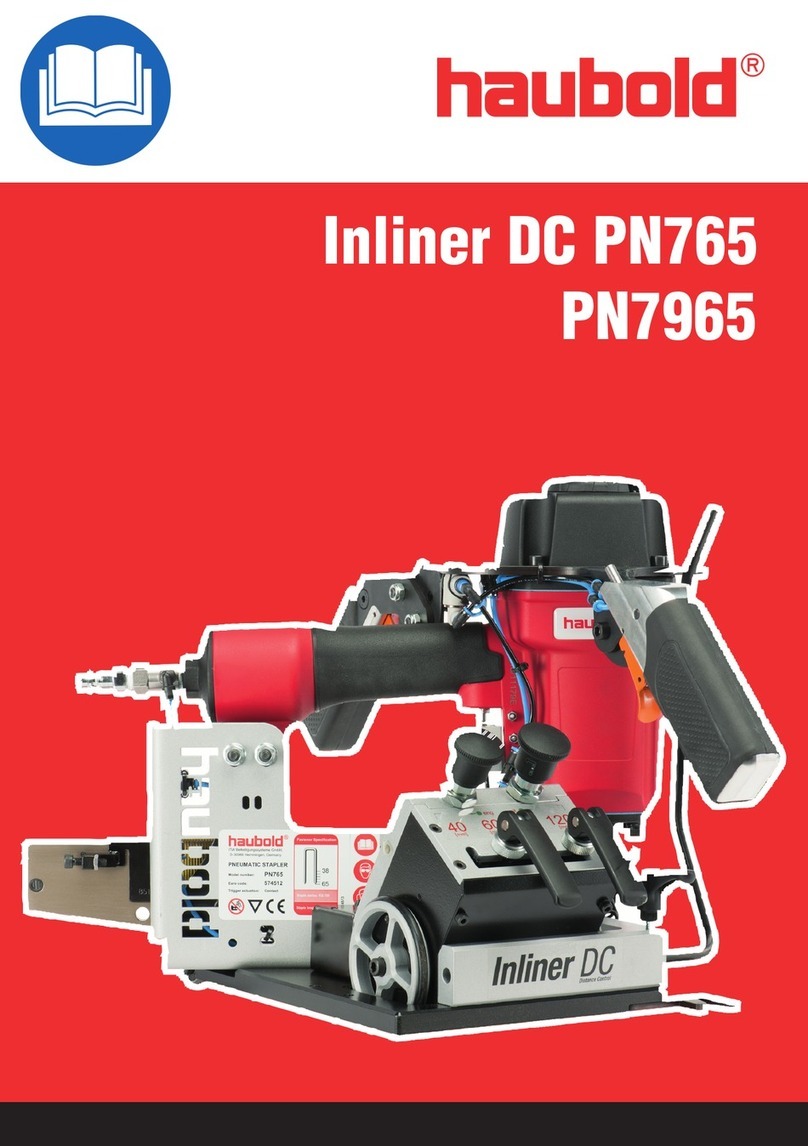
haubold
haubold Inliner DC PN765 manual
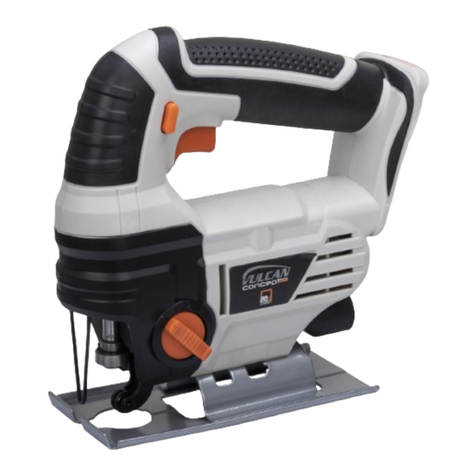
PROFIX
PROFIX Vulcan Concept VJR50 Operating instruction
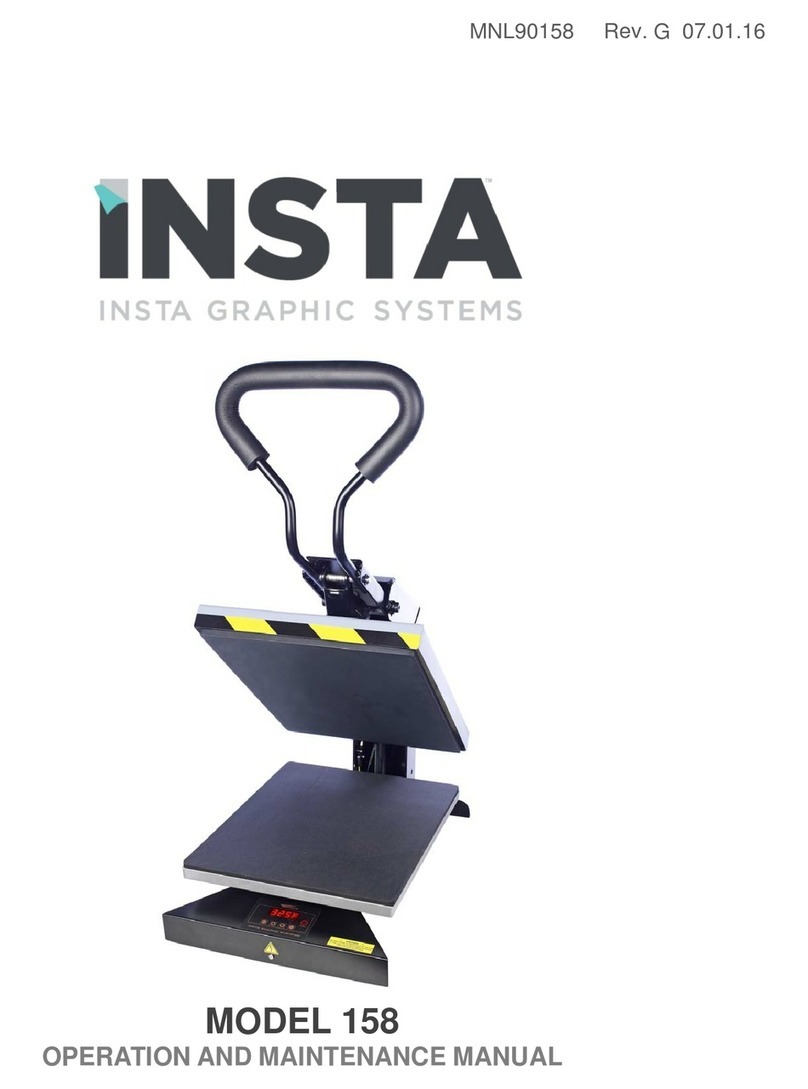
Insta Graphic Systems
Insta Graphic Systems 158 Owner's operation and maintenance manual

Optimum
Optimum OPTImill MH 25V operating manual

Makita
Makita Makstar BSS610 instruction manual
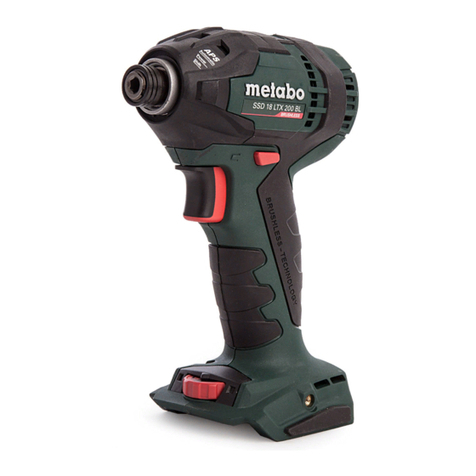
Metabo
Metabo SSD 18 LTX 200 BL Original instructions
